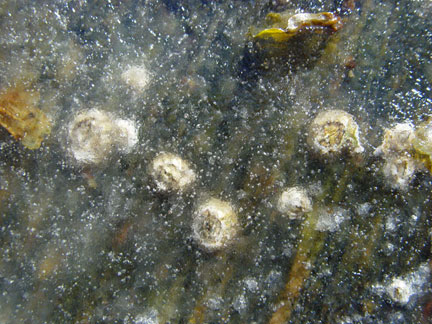 |
 |
|||||||||||||||
|
The barnacle has other interesting adaptations. It can survive harsh winter conditions as shown in the image above, by trapping sea water inside its shell. Winter ocean water temperatures in Maine hover around 32°F, the temperature at which fresh water freezes. However, sea water at an average salinity of 35 ppt, begins to freeze around 28°F and varies depending on the salinity of the ocean water. The rock that the barnacle is secured to will attract and absorb sunlight, warming the area immediately surrounding the barnacle. This combination results in a warmer internal temperature of the barnacle in comparison to the air temperature. During periods of extreme heat in the summer, the barnacle again uses trapped sea water, this time as a cooling system through the process of evaporation. The barnacle's shell also has some important, adaptive features. The conical or tent-like shape of the shell allows it to diffuse the energy of pounding waves preventing it from being dislodged from the rock.The shell color is white and reflects sunlight keeping it's internal temperature cooler in the summer. |
||||||||||||||||
|
||||||||||||||||
|
||||||||||||||||


